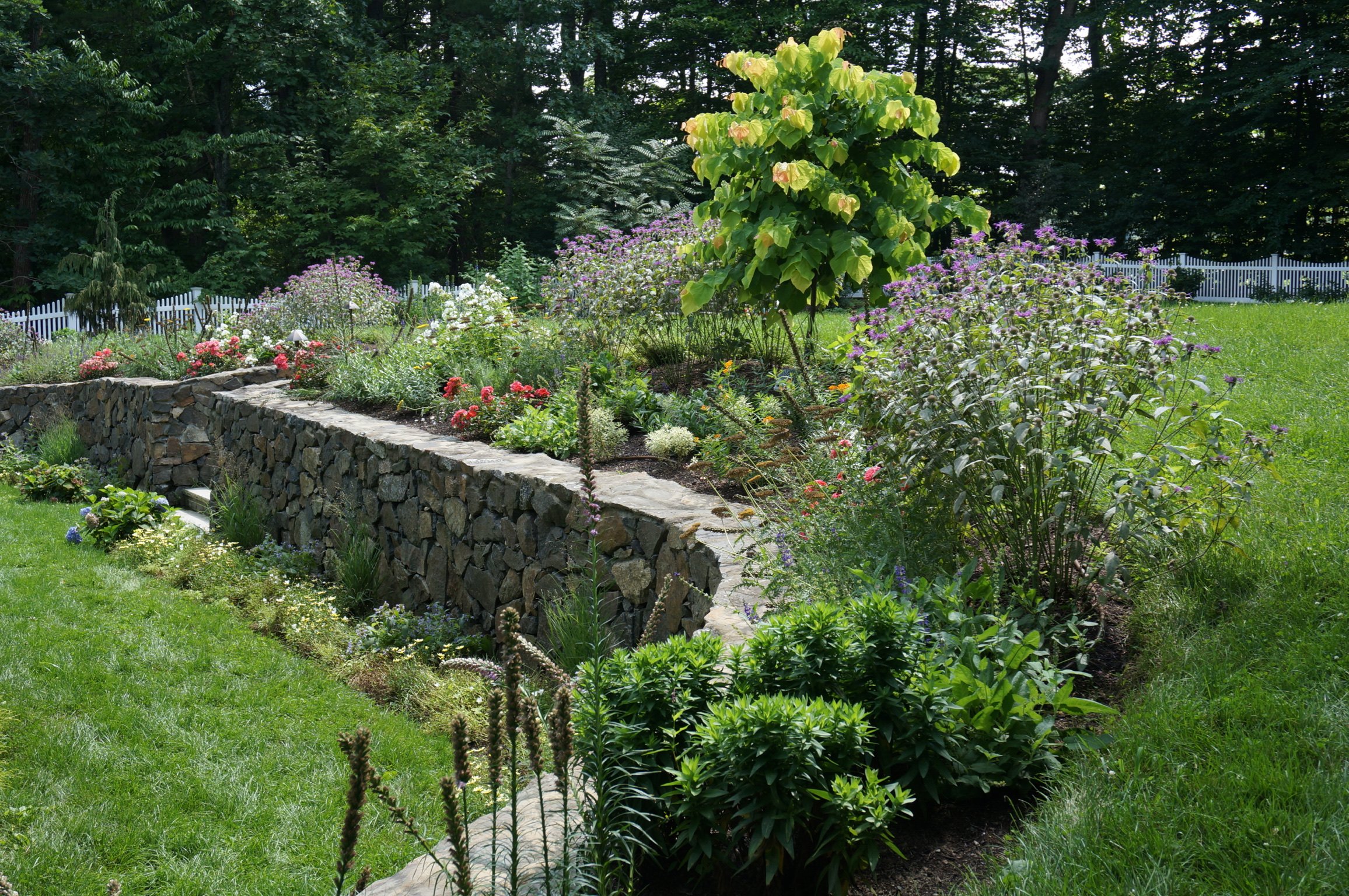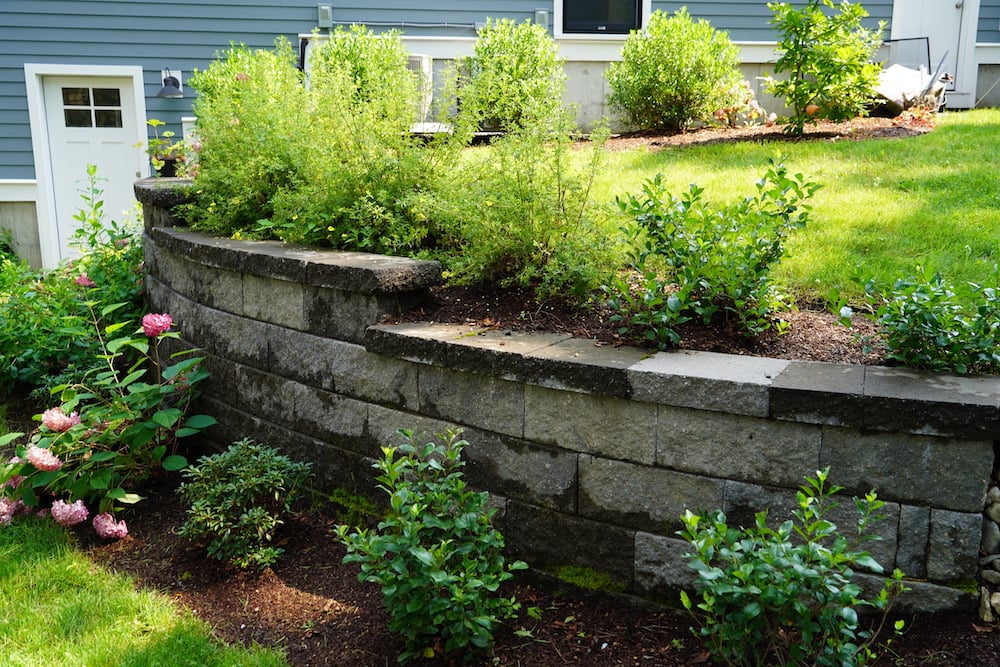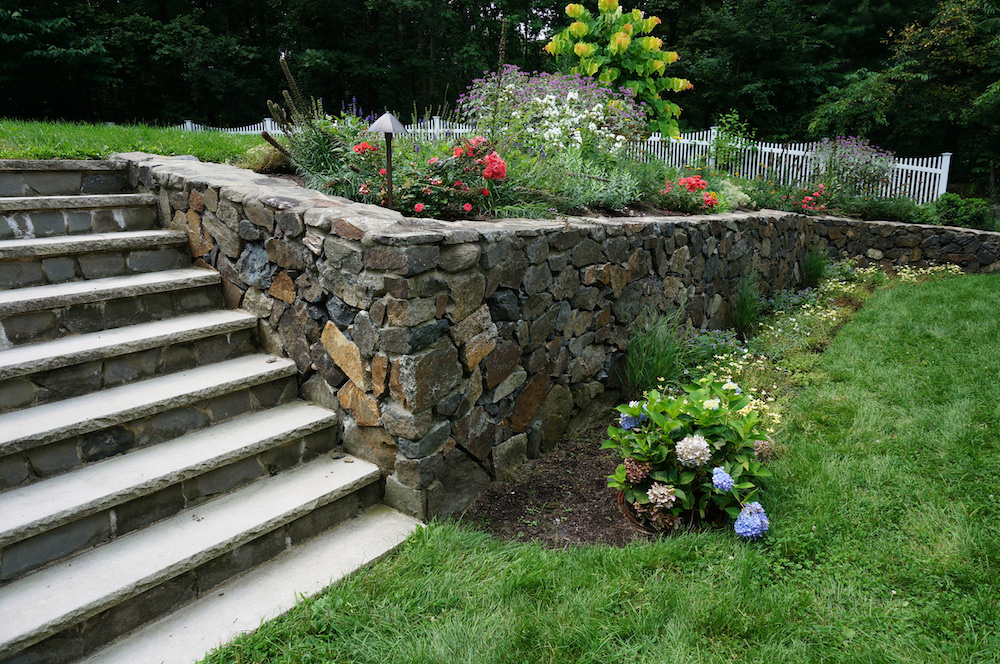Retaining walls are the multitaskers of the home landscape. They can hold back soil, prevent soil erosion and add needed structure — all while boosting your landscape’s beauty and curb appeal.
Whether you’re taming a sloped yard, combating erosion or adding a touch of elegance to your outdoor space, the right retaining wall can transform your landscape. Whatever your need, there’s a retaining wall to fit every landscape challenge and personal style.
There are many different types of retaining walls to consider for your home landscape. Let’s explore the possibilities for a landscape retaining wall that’s both sturdy and stunning.
Common Types of Retaining Walls
Gravity Retaining Walls
With their picturesque charm and timeless aesthetic, stone walls are a quintessential feature of Massachusetts landscapes. But in addition to the beauty they add to a landscape, this type of retaining wall has an important functional purpose.
Peek behind the beautiful stonework and you’ll likely find heavy, compacted soil, without any additional support. That’s because stone walls are typically constructed as gravity retaining walls.

These walls are self-supporting, meaning they use their own weight to resist the pressure of the soil. This function is unique compared to other types of retaining walls.
A gravity retaining wall’s stability comes from the heavy and strong materials that are used to construct them. In addition to stone, concrete blocks and brick are common materials used in gravity retaining walls.
Segmental Retaining Walls
While segmental retaining walls function as a type of gravity retaining wall, it has some unique features worth exploring on their own. One of the most significant ways this type of retaining wall stands out is its materials.
Unlike other gravity retaining walls that use materials such as natural stone sourced from a quarry, segmental retaining walls are built with manufactured interlocking blocks.

One way to think of it is as a retaining wall system — rather than being uniquely crafted by a mason, a segmental retaining wall is a pre-planned, uniformly-designed wall structure. Mortar is not needed for this wall construction.
Block walls like these are an attractive choice to many homeowners for their ease of installation, which is less labor-intensive than other options and decreases costs. Because they are factory-made, they also are available in a wide variety of colors and finishes, which allows homeowners to select options perfectly tailored to their individual styles.
Anchored Retaining Walls
Anchored retaining walls are the daredevils of the landscaping world — holding back massive loads with the help of some hidden reinforcements.
For stability, anchored retaining walls are built with steel rods or cables anchored into the ground below, connected by a component called a tieback. This design ensures they stay in place, no matter how much soil they’re holding back.

Because they carry an exceptionally heavy load, anchored retaining walls are generally made with cast-in-place concrete. Unlike precast concrete, which is fabricated at a separate location, cast-in-place concrete is made directly at the construction site using a mold. This approach affords flexibility for complex projects.
Anchored retaining walls are perfect for residential landscapes with steep slopes, tight spaces or ambitious designs. They offer stability without compromising style.
Cantilever Retaining Walls
Cantilever walls are a workhorse of the residential landscape. Mechanically, a cantilever retaining wall operates as a lever. A vertical element retains the soil, while a base slab stabilizes the retaining wall by efficiently distributing the soil’s load into the ground.
This efficient design makes cantilever retaining walls ideal for landscapes that require taller wall heights. Reinforced retaining walls also are suitable for hilly areas or steep slopes, as they can be built to accommodate the shape of the land, as well as contain large amounts of soil. They are commonly constructed with reinforced concrete.
Cantilever walls are well-suited to the freeze-thaw cycle of the Massachusetts climate. This is for a few reasons. First, their retaining structure is highly resistant to the stress that can occur when temperatures regularly alternate from warm to freezing.
In addition, freezing winter temperatures can cause changes to the soil conditions. Freezing groundwater causes retained soil to expand, exerting more pressure on the wall. Cantilever retaining walls can distribute this extra soil pressure effectively, thanks to its reinforced design.

From timeless stone walls to modern reinforced structures, different retaining wall types offer unique benefits to suit a variety of needs. Now that you know about the various types, you’re equipped to choose the perfect retaining wall to enhance your landscape and bring your outdoor vision to life.
For more information about building a home hardscape like a retaining wall, download our free ebook, The Expert Guide to Building the Custom Home Hardscape of Your Dreams.

To begin a discussion about a new hardscape for your home, you can contact us here for a project consultation. Whether you're in the beginning stages of a new project or still considering if it's the right choice for you, we'd love to talk to you!






